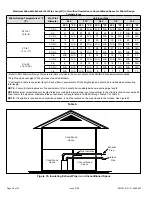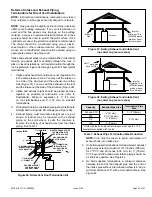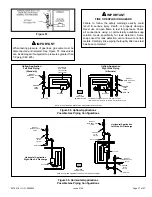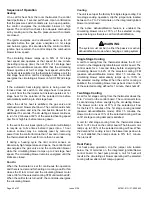
507961-01G / 31-5000653
Page 33 of 57
Issue 2128
Condensate Piping
This unit is designed for either right or left side exit of
condensate piping in upflow applications. In horizontal
applications, the condensate trap must extend below the
unit. An 8” service clearance is required for the condensate
trap. Refer to Figure 49 and Figure 51 for condensate trap
locations. Figure 55 shows trap assembly using 1/2” PVC
or 3/4” PVC.
Plug
(same on
left side)
Trap
(same on
right side)
1-1/2 in.
Figure 49. Condensate Trap and Plug Locations
(Unit shown in upflow position)
NOTE:
In upflow applications where side return air filter is installed
on same side as the condensate trap, filter rack
MUST
be installed
beyond condensate trap or trap must be relocated to avoid
interference.
NOTE:
If necessary the condensate trap may be installed
up to 5’ away from the furnace. Use PVC pipe to connect
trap to furnace condensate outlet. Piping from furnace
must slope down a minimum of 1/4” per ft. toward trap.
1. Determine which side condensate piping will exit the
unit, location of trap, field-provided fittings and length
of PVC pipe required to reach available drain.
2.
Use a large flat head screw driver or a 1/2” drive
socket extension and remove plug (Figure 49) from
the cold end header box at the appropriate location
on the side of the unit. Install provided 3/4 NPT street
elbow fitting into cold end header box. Use Teflon tape
or appropriate pipe dope.
3. Install the cap over the clean out opening at the base
of the trap. Secure with clamp. See Figure 55.
4.
Install drain trap using appropriate PVC fittings, glue
all joints. Glue the provided drain trap as shown in
Figure 55. Route the condensate line to an open drain.
Condensate line must maintain a 1/4” downward slope
from the furnace to the drain.
Do not use copper tubing or existing copper condensate
lines for drain line.
CAUTION
5. Figure 51 and Figure 52 show the furnace and
evaporator coil using a separate drain. If necessary
the condensate line from the furnace and evaporator
coil can drain together. See Figure 53 and Figure 54.
Upflow furnace (Figure 50) - In upflow furnace
applications the field provided vent must be a minimum
1” to a maximum 2” length above the condensate drain
outlet connection. Any length above 2” may result in a
flooded heat exchanger if the combined primary drain
line were to become restricted.
Horizontal furnace (Figure 51) - In horizontal furnace
applications the field provided vent must be minimum
4” to a maximum 5” length above the condensate drain
outlet connection. Any length above 5” may result in a
flooded heat exchanger if the combined primary drain
line were to become restricted.
NOTE:
In horizontal applications it is recommended to
install a secondary drain pan underneath the unit and
trap assembly.
NOTE:
Vinyl tubing may be used for condensate drain.
Tubing must be 1-1/4” o.d. X 1” i.d. and should be
attached to the drain on the trap using a hose clamp.
6. If unit will be started immediately upon completion of
installation, prime trap per procedure outlined in Unit
Start-Up section.
Condensate line must slope downward away from the
trap to drain. If drain level is above condensate trap,
condensate pump must be used. Condensate drain line
should be routed within the conditioned space to avoid
freezing of condensate and blockage of drain line. If
this is not possible, a heat cable kit may be used on the
condensate trap and line. Heating cable kit is available in
various lengths; 6 ft. (1.8 m) - kit no. 26K68; 24 ft. (7.3 m) -
kit no. 26K69; and 50 ft. (15.2 m) - kit no. 26K70.
Figure 50. Condensate Trap Locations
(Unit shown in upflow position with remote trap)
*Piping from furnace must slope down a minimum of 1/4” per
ft. toward trap.
















































